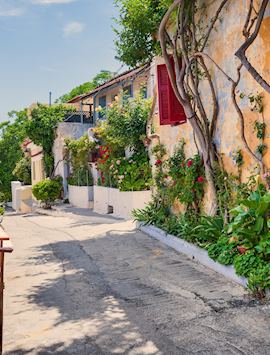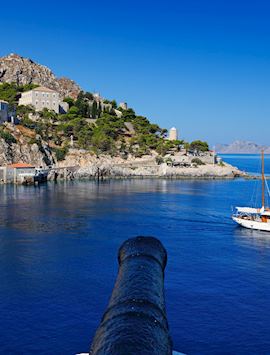Blindingly white beaches. Sleepy villages. Mountain forest trails. Centuries-old vineyards. Calm seas in every shade of blue. And history at every turn.
From the Cycladic islands of Mykonos and Milos, where whitewashed villages tumble down to azure bays, to the cities of Athens and Heraklion, where ancient relics rub shoulders with lively towns (and tavernas) — Greece draws a crowd for many reasons.
You might hike along millennia-old trails to a 4th-century church on Paros, paddle atop gin-clear waters to the sunken ruins at Epidavros, or watch the sun slip into the Aegean while walking the rim of Santorini’s flooded caldera.
During your Greece trip, we can arrange for you to stay in authentic properties, from a cave hotel dug out of the caldera to a former Venetian sea captain’s house.
Pick your trip:
1. Athens & the Greek Islands
From the classical-meets-contemporary buzz of the capital to the bohemian, go-slow island of Hydra — it’s an easy leap from Athens to the Saronic and Cycladic islands. In one trip, you can flit between ancient ruins and street art, quaint harbours and Venetian castles, rocky coves and mountain passes, white-sand beaches and sunken wrecks, and seek out seaside tavernas that dish up chilled ouzo alongside fresh-from-the-sea grilled octopus.
Where this trip could take you:
As with most tours to Greece, you’ll fly into Athens. You can spend a few days exploring the city’s landmark sights and lesser-visited spots — all at your own pace. From here, we suggest taking a private boat to the car-free tiny island of Hydra. Then, you can cross the Aegean from Athens to the less-crowded Cycladic island of Milos and island hotspots Santorini and Mykonos for a mix of land and sea adventure.
What experiences you could have:
Guided tours will shine a light on landmark and lesser-known ancient sites — from the catacombs on Milos where the Venus de Milo was discovered, to the tiny island of Delos, which in Greek mythology was the birthplace of Apollo.
You might choose to experience the Acropolis at sunrise when the light casts a warm glow on the Parthenon and the crowds are low. Or, for a glimpse into the ancient Minoan culture that once occupied Santorini, we can arrange a private tour of the archaeological remains of Akrotiri. Destroyed by a volcanic eruption thousands of years ago, this settlement was unearthed in the 1960s, revealing amazingly well-preserved buildings, just like at Pompeii.
The Cycladic islands sprung from volcanic origins, and you can bathe in volcanic hot springs on Santorini, where the sulfur-rich waters are said to smooth the skin. For a more active option, we can arrange a tour with a geologist, to explore the volcanic island of Milos through its eye-catching coves and lunar-like beaches.
And if it’s the wine that appeals, you can visit a family-run winery on Santorini to discover the more than 40 grape varieties that are grown on the island. Here, you’ll sample reds, whites, and a rosé on the terrace as you watch the sun descend over the Aegean, throwing its warm hues across the caldera.

2. Highlights of Ancient Greece
Athens, Epidavros, Delphi, and Olympia — the birthplace of the Olympic Games — all link together to create a route with undemanding journey times that immerses you in the history and culture of ancient Greece. But, with more to this area than the classics, there’s plenty of time for adventure and relaxation, from mountain hiking to vineyard-hopping.
Where this trip could take you:
Starting in Athens and zigzagging the mainland, you’ll explore UNESCO-listed archaeological sites and lesser-known relics. Journeying south to the Peloponnese, you’ll pass through the mountains of Korinthia, where lakes, evergreen forests, and tiny villages unfold. En route, you can visit Olympia, home of the Olympic Games, stop off at the ancient ruins of Mycenae, and explore the Venetian seaside town of Nafplio. It’s a ferry trip from Athens across to Mykonos and then Delos, “the most sacred of all islands” in ancient Greek culture.
What experiences you could have:
The Peloponnese is Greece’s mythical heartland, and here among the mountains and valleys, you’ll find archaeological sites of staggering import. We recommend visiting Olympia, the birthplace of the Olympic Games and former site of the Statue of Zeus, where a private guide can bring the mosaics, statues, and myths to life.
To experience classical Greek from a different perspective, we can arrange a kayaking trip to the sunken city of ancient Epidaurus. You’ll paddle the Peloponnese coastline, stopping at tucked-away coves and sandy beaches before reaching the Mycenaean-era ruins. Here, in the crystal-clear waters, you can snorkel above the easily visible remains of an ancient Roman villa.
Beyond the Peloponnese, ancient Delphi on the slopes of Mount Parnassus, is where the oracle was said to give prophecies, and the long-abandoned island of Delos, and birthplace of Apollo, is a short boat trip from Mykonos.
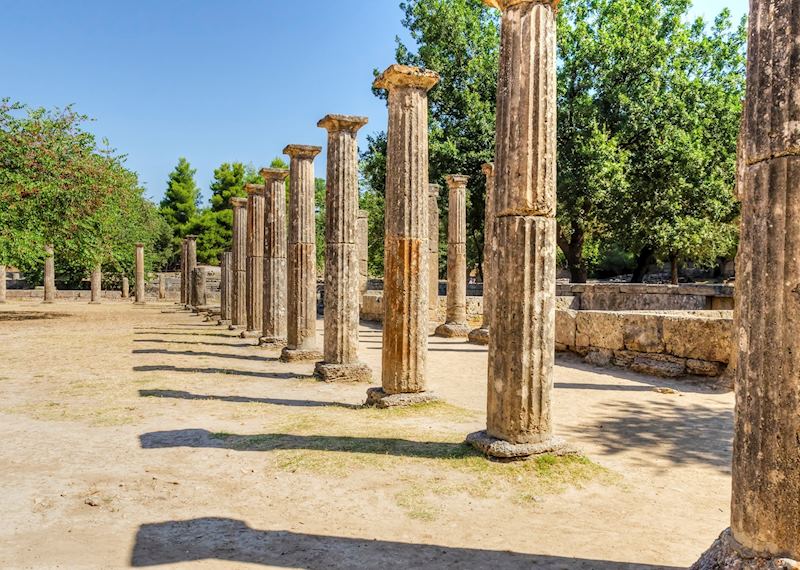
3. Cycladic Islands: Milos, Paros & Naxos
Compared with sister Cyclades Santorini and Mykonos, the quieter islands of Milos, Paros, and Naxos offer a slower pace, fewer crowds, and more rustic appeal. They represent a more authentic version of Greek island life, where you can take a dip in hot springs or rustle up hyperlocal dishes in the family homes of island residents.
Where this trip could take you:
Arriving in Athens, you can spend time exploring the capital before crossing the Aegean to the Cycladic islands. We suggest taking a ferry first to Milos, before sailing to Paros with a final ferry hop over to Naxos. The islands sit within a few hours’ sailing time of each other. In all three Cyclades, you’ll find plenty of options for adventure and relaxation with guided tours and private boat trips to explore nearby islands.
What experiences you could have:
You could explore the lunar landscape of Milos through the eyes of a geologist, who’ll unpack the island’s history through its chalk-white moon-like rock formations and rust-red caves.
For a more adventurous approach, you can trek through the island’s inactive volcano to spot the steam that continues to stream through cracks in the ground 90,000 years on from eruption. Or, hike across rocky Byzantine paths on Paros to Ekatontapiliani, the “Church of 100 Doors”.
For a closer look at life on the islands, we can arrange for you to tour the oldest winery on Paros, to taste pairings of crisp whites and Cycladic cheeses. You could also opt to visit the home of a Naxos villager, where you can learn to make local delicacies like sefoukloti, a pie filled with wild greens from the Naxian mountains.
In it for the beaches? There are more than 70 on Milos, from soft sand spits to Sarakiniko, where bone-white all-smooth volcanic rocks penetrate the emerald waters. And, from Paros, we recommend a private catamaran cruise to search out the longest crystalline beaches in the Aegean.

4. Family outdoor Greece
Rich in scenery and packed with archaeological sites, this tour of Greece criss-crosses the mainland and takes in one of the Cycladic islands. You’ll have the opportunity to explore the history and geology of Greece but with an adrenaline-fuelled punch, from zipping around ruined monasteries on an e-bike to bumping along forested slopes on a 4x4 safari in the Pindus Mountains.
Where this trip could take you:
Flying into Athens, you’ll spend time exploring the city before embarking on a journey north to the Thessaly region. You’ll have the opportunity to visit ancient Delphi and the town of Kastraki, located under the otherworldly Meteora Hills. On the way, we recommend breaking up the journey at Lake Plastiras, surrounded by snow-capped mountains and pine forests. Journeying south to Cape Sounion, known for its sunsets, you’ll have time to relax and explore, before taking a short flight to Milos, for some island and sea adventure.
What experiences you could have:
Learning about classical Greece isn’t just for grown-ups. We can bring the country’s ancient myths and monsters to life with private tours. You might choose to visit Delphi, where the oracle of Apollo spoke, to discover the mythical connections with adventure-book series Percy Jackson, or join an e-bike tour in Meteora to learn about the mysteries behind these clifftop Byzantine monasteries.
Close by the monasteries, we can arrange for you to join a truffle hunter and his dogs in Kastraki for a brisk walk in the woods, to sniff out (and then cook) these prized delicacies.
On the water, there’s kayaking the coastline of Milos to explore the island’s moonscape beaches, multi-hued caves, and tiny coves. And, a hike over volcanic ash and alongside hidden bays takes you to a sunken ship off the coast.
You have plenty of time for the beach, too. Choose from one of 70 beaches on Milos, from wide golden sands to pebbly coves. And, at Cape Sounion, we recommend a stay at the Grecotal Cape Sounio, whose palm-fringed beaches rival those of the Caribbean.

5. Discover Crete
Ancient ruins, mountain peaks, sugar-white beaches, vineyards, Minoan culture, and canyons galore. Greece’s largest (and most storied) island, the birthplace of Zeus, is so distinct in terrain, history, culture, and cuisine, it could be its own country. It’s awash with under-the-radar archaeological sites, woodland hiking trails, and the freshest seafood.
Where this trip could take you:
Starting in Heraklion, you’ll have plenty of time to tour Crete’s capital with a private driver and guide, before heading east to the coastal town of Elounda. From here, you can visit the ancient Palace of Knossos, the setting for the Minotaur myth. During your time in Elounda, you can travel by private boat to the uninhabited island of Spinalonga, by turns a Venetian fortress and leper colony. Then, it’s back to Heraklion for your flight home.
What experiences you could have:
Crete is known for its ancient Minoan culture, which you can explore on a private tour of the Palace of Knossos, which comes with 4,000 years of history and panoramic sea views.
We also suggest a visit to the Heraklion Archaeological Museum, whose treasure trove of Minoan artifacts includes pottery, jewelry, and sarcophagi. Or, for a more hands-on approach, hike the winding trail to the mountain village of Mochos to paint ceramics in traditional Minoan style.
You can sample bougatsa, a crispy breakfast pastry filled with custard, on a street tour of the seaside town (and food hotspot) Chania. Or, you might prefer to visit an 18th-century olive mill in a village, where you can help prepare traditional dishes using herbs foraged from the mountains.
We can also arrange for you to tour a winery and olive oil producer — where, alongside tastings, you can bask in the shade of the olive tree of Vouves. Its branches are used to create the wreaths awarded to marathon winners at today’s Olympic Games.
And, to embrace the island’s unspoilt scenery, you might prefer a guided hike through the Samaria Gorge, one of Europe’s longest, with its forests and rare wildlife, such as the kri-kri, a Cretan goat that can only be found here.

6. Athens & the Peloponnese
If you want a trip that soaks up as much of Greece’s past as possible, this tour is it. Steeped in history, legend, and unblemished natural beauty, the remote mountainous Peloponnese is not only home to some of the country’s most revered archaeological sites, but to vineyards and forests, medieval walled towns, unspoilt beaches and coves — and a slower pace of life.
Where this trip could take you: Start in Athens and spend a few days unpacking the capital’s many highlights. Then, it’s a journey south to the less-visited Peloponnese, whose geographic diversity — seascapes, small villages, forests, and mountain passes — can make it feel like Greece in miniature. Here, you can visit the seaside town of Nafplio and the archaeological site of Epidavros. You can also take the 30-minute ferry crossing to the island, and artist’s colony, of Hydra.
What experiences you could have:
Besides the big archaeological sites, such as the Acropolis and the pristinely preserved theater at Epidavros, we can introduce you to Byzantine churches, Venetian mansions, a hilltop fortress, and a sunken city on private guided tours.
On sleepy, car-free Hydra, lying off the eastern tip of the peninsula, you can hike to the island’s highest peak. Following trails that wind through the island’s terraced fields and pine forests, you’ll reach a monastery and viewpoint high above Hydra’s harbor.
A private sailboat cruise of the Peloponnese’s cove-riddled coast, where you can swim and snorkel, offers up an alternative perspective.
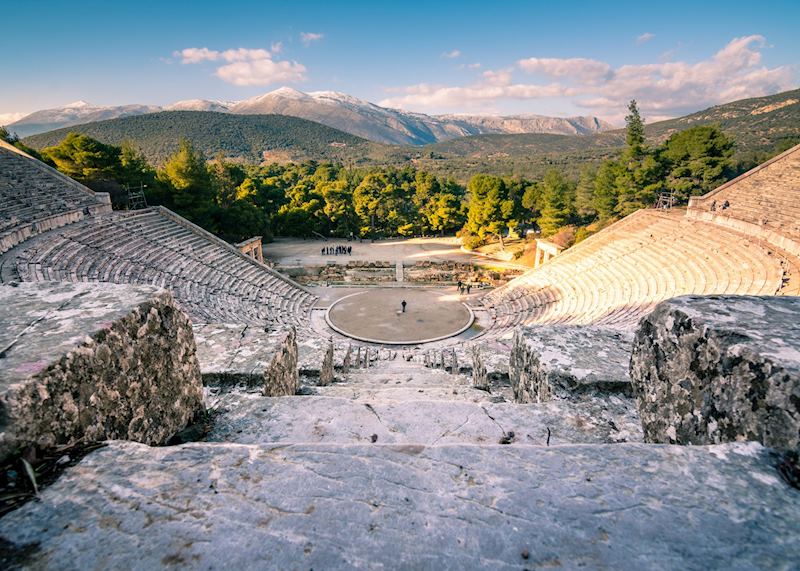
7. Greek honeymoon: Santorini & Mykonos
White churches with blue domes, pink bougainvillea, and some of the most photographed sunsets in the world — these two Cyclades sell themselves on romance. But, beyond the drama of Santorini’s caldera and Mykonos’s party scene, you’ll discover vineyards and villages, coves and beaches only accessible by boat, and seaside cafés serving just-caught fish.
Where this trip could take you:
You can fly in and out of Mykonos, hopping across the Aegean to Santorini, a two-hour ferry ride. Alternatively, you can choose to fly in and out of Santorini instead. On both islands, you can opt for private tours, by car, boat, and on foot, to pepper your relaxation time.
What experiences you could have:
On the water, we can arrange a speed boat trip to discover Mykonos’s many coves and the caves of nearby deserted islands. Or, you can take a private catamaran tour around Santorini, to soak up vistas of cliffside towns and lava formations, interrupted only by dips in the sea.
For a more active option, you can take a guided hike to the Santorini village of Oia, with its age-old windmills and high-flung castle. Here, you’ll be rewarded with stops-you-in-your-track scenes of white architecture and blue-domed churches against a backdrop of sparkling water and then the sun’s final descent over the flooded caldera’s black rim.
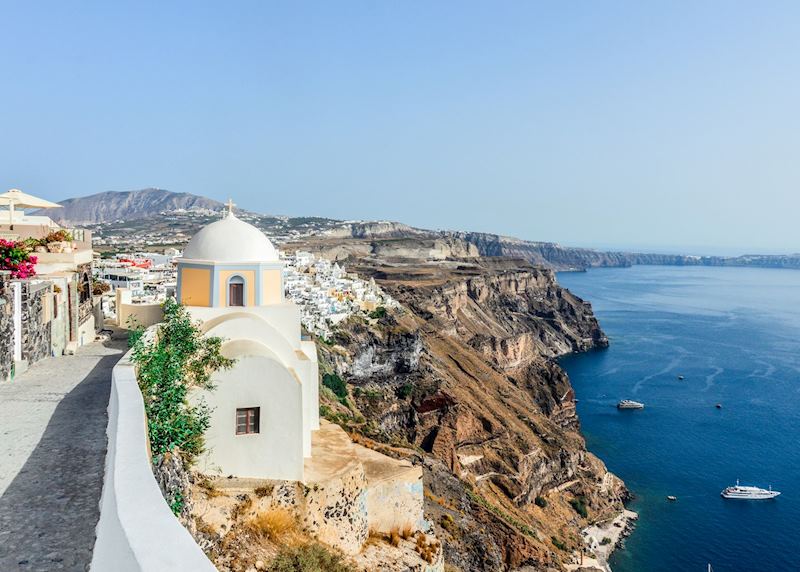
8. Athens & Nafplio
Crumbling temples. Sunken cities. Rocky cliffs. And an explosion of eye-catching graffiti. From one of the world’s oldest (and most vibrant) cities to the Venetian waterfront town of Nafplio, on the Peloponnese, this pairing of Athens and Nafplio will help you get to know Greece from a local’s perspective.
Where this trip could take you:
Flying into Athens, you can see the city from unusual angles with a private guide. From here, you can journey to the Peloponnese where you can explore forests and mountain villages, and visit the Venetian city of Nafplio, with its three castles and many beaches. An area bursting with ancient ruins, and entwined in mythology, here you can visit Mycenae, Epidavros, among other sites. You might also take the ferry across to Hydra, to discover this car-free island.
What experiences you could have:
In Athens, with a private guide, you can visit the Acropolis and its crowning glory, the Pantheon, at its finest hour, when the crowds are dwindling, and the evening sun turns the marble golden.
You might also tour the imposing ruins of Mycenae, where the inspiration for Homer’s Epics started, or the ancient city of Epidavros — once revered across the Mediterranean as a place of miraculous healing. You can explore the well-preserved theater ruins, or swim (and snorkel) over a sunken city where fish dart between the Mycenaean-era ruins.
Back in the capital, you can join a street-art tour where an expert breathes life and perspective into the artists and stories behind the city’s lively murals.
Alternatively, to explore Athens through its food, you could join a street-food tour that takes in the best places for souvlaki, ouzo, and loukoumades (honey-soaked doughnuts) or at a winery, raise a glass of retsina to Dionysus, the Athenian patron of the vineyards.
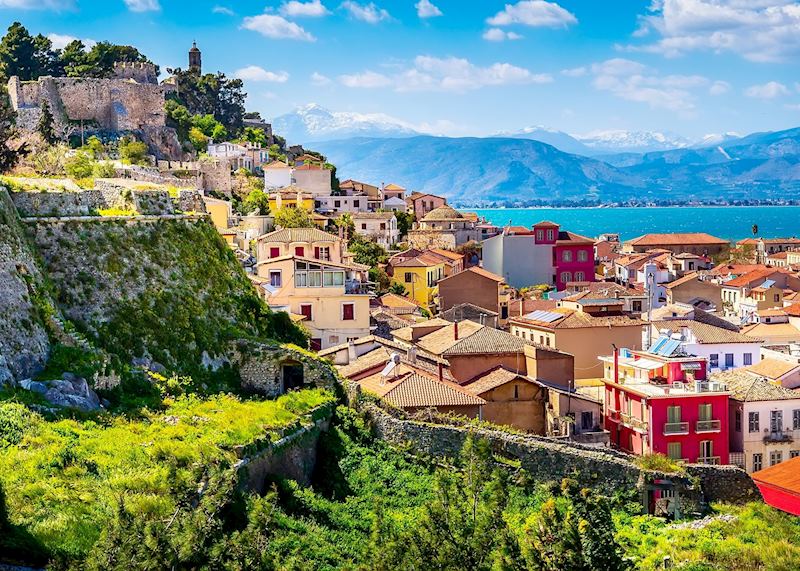
Read more about trips to Greece
Start thinking about your experience. These itineraries are simply suggestions for how you could enjoy some of the same experiences as our specialists. They're just for inspiration, because your trip will be created around your particular tastes.
View All Tours in Greece

